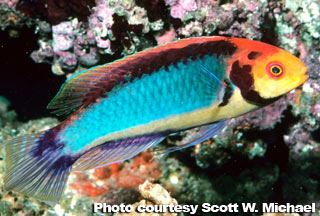
The Best Reef Wrasses; Part 2
By Scott W. Michael
The genus Cirrhilabrus is the second largest genus in the wrasse family. There are over 45 species currently recognized and more to be described. On the reef, fairy wrasses form feeding shoals, with females typically outnumbering males in these groups. Individuals swim up in the water column (sometimes up to 20 feet in the water column) and feed on zooplankton swept past by ocean currents. They often join with groups of other zooplanktivores, like flasher wrasses (Paracheilinus) and plankton feeding damselfishes. Some fairy wrasses aggregate with congeners (members of the same genus) and may hybridize on occasion. The majority of Cirrhilabrus spp. prefer coastal reef habitats and are often found over coral rubble substrate, mixed sponge-macroalgae beds or over coral reefs comprised mainly of large-polyped stony corals. They often hang over small coral mounds, soft corals or stands of macroalgae, in which they retreat if danger threatens. There are some fairy wrasses that are found on clean oceanic reefs, where they live among luxuriant live coral growth on the reef face or fore reef slope.
While the smaller fairy wrasses are a good choice for the beginning as well as the advanced hobbyist, larger individuals often have great difficulty adjusting to captivity and more frequently succumb to the rigors of capture and shipping stress. The larger males are often much more colorful than the juveniles or females and are therefore a more tempting prospect for the aquarist. If you decide to try a larger individual, do not purchase it until it is feeding and behaving normally (e.g., swimming about the aquarium). Also look at the tip of its snout to make sure that the skin was not abraded during transport. Some individuals, in their vigorous attempts to break out of the shipping bag, will rub their snout raw. This is a potential site for viral and bacterial infections. In the aquarium, male fairy wrasses will fight each other and may display some, but rarely lethal, aggression toward other fish introduced after them. The latter is more likely if they are closely related (e.g., other fairy and flasher wrasses) or are small docile species. As is the case with many coral reef fishes, fairy wrasses are more likely to attack species with similar color, form or behavior. In the aquarium, fairy wrasse aggression usually consists of chasing and charging, however, they will occasionally nip at and may injure an opponent. I would avoid keeping these wrasses with groupers, large dottybacks, larger angelfishes, aggressive wrasses (e.g., Thalassoma spp.), most triggerfishes and large puffers. Another potential threat to fairy wrasses are the carpet sea anemones (Stichodactyla spp.) and the adhesive sea anemone (Cryptodendrum adhaesivum). These invertebrates have been known to capture these wrasses at night.
There is one drawback to keeping male Cirrhilabrus on their own. While color loss in many reef fishes can be attributed to an improper diet, in male fairy wrasses chromatic changes are more often the result of a lack of social interactions with conspecifics. If these fishes are not kept together, the males color (and possibly his gender) will begin to revert back to that of the female. For example, it is not uncommon for male Scott's Fairy Wrasse (Cirrhilabrus scottorum) to lose the bright red blotch on their sides (a chromatic feature of the male) if they are not housed with members of their own kind.
It is important to feed these wrasses at least twice a day to ensure they do not become emaciated and subsequently perish. Most foods will be accepted, but a variety of finely chopped fresh seafood (e.g., shrimp, marine fish flesh), frozen mysid shrimp,CYCLOP-EEZE® and a good frozen prepared food will help to maintain their colors and good health. One sign of inadequate nutrition is atrophying dorsal musculature. When this occurs, the head seems to enlarge as the adjoining muscle tissue shrinks in mass. I have seen this condition frequently in individuals housed in reef aquariums that were fed infrequently. Although in nature they feed primarily from the water column, fairy wrasses will pick food off aquarium substrate as well.
 Scott Michael
Scott MichaelScott W. Michael is an internationally-recognized writer, underwater photographer, and marine biology researcher specializing in reef fishes, and was the Banquet Speaker at our 2007 and 2008 Coral Conference and Frag Swap. He is a regular contributor to Aquarium Fish Magazine, Freshwater and Marine Aquarium Magazine, SeaScope, and is the author of Reef Fishes Vol 1, Vol 2, and Vol 3, Vol 4, and Vol 5., A Pocket Expert Guide Marine Fishes, A Pocket Expert Guide to Reef Aquarium Fishes, 101 Best Saltwater Fishes: How to Choose and Keep Hardy, Brilliant, Fascinating Species That Will Thrive in Your Home Aquarium, Reef Sharks & Rays of the World, and Aquarium Sharks & Rays. Having studied marine biology at the University of Nebraska, Scott has served as a scientific consultant for National Geographic Explorer, the Discovery Channel, and French educational television. |
|||||||||||
|
|


 The fairy wrasses are good additions to the reef aquarium. With the possible exception of small, delicate shrimps, these wrasses usually do not harm invertebrates. Fairy wrasses are shy when initially introduced to the aquarium, often hiding for several days. But if a peaceful acclimation period is provided, they will become quite brazen, even to the point of nipping or laying against the aquarist's hand or forearm as he or she cleans their aquarium. The main key to successful acclimation is to place them in an aquarium with nonaggressive species. If they are introduced to a tank with belligerent fish, they typically stay hidden and end up starving to death or succumbing to disease. It is also important that there is limited human activity inside and outside of the aquarium during this acclimation period.
The fairy wrasses are good additions to the reef aquarium. With the possible exception of small, delicate shrimps, these wrasses usually do not harm invertebrates. Fairy wrasses are shy when initially introduced to the aquarium, often hiding for several days. But if a peaceful acclimation period is provided, they will become quite brazen, even to the point of nipping or laying against the aquarist's hand or forearm as he or she cleans their aquarium. The main key to successful acclimation is to place them in an aquarium with nonaggressive species. If they are introduced to a tank with belligerent fish, they typically stay hidden and end up starving to death or succumbing to disease. It is also important that there is limited human activity inside and outside of the aquarium during this acclimation period.  If you want to keep more than one fairy wrasse, try maintaining a harem consisting of one male and several females. In order to avoid fighting between harem members, it is important to introduce them simultaneously or to add the females first. Then after the females have adjusted to the tank, add the more aggressive male. You are much more likely to have success in keeping groups of fairy wrasses if you place them in a larger aquarium (in small tanks even females may not get along or males may pester females to death). Males of the larger species of fairy wrasses should never be housed in the same tank, while those representing smaller species can be if the aquarium is large enough (e.g., 180 gallons or larger). In some cases, if a submissive male can avoid being beaten-up and killed by an aggressive consexual, it may reverse sex and become a functional female.
If you want to keep more than one fairy wrasse, try maintaining a harem consisting of one male and several females. In order to avoid fighting between harem members, it is important to introduce them simultaneously or to add the females first. Then after the females have adjusted to the tank, add the more aggressive male. You are much more likely to have success in keeping groups of fairy wrasses if you place them in a larger aquarium (in small tanks even females may not get along or males may pester females to death). Males of the larger species of fairy wrasses should never be housed in the same tank, while those representing smaller species can be if the aquarium is large enough (e.g., 180 gallons or larger). In some cases, if a submissive male can avoid being beaten-up and killed by an aggressive consexual, it may reverse sex and become a functional female.  The fairy wrasses are very good jumpers. Therefore, you will need to be careful when working in the tank or when extinguishing the lights. Ambient light levels should be reduced gradually so that you do not frighten your fairy wrasse. One way to prevent them from becoming startled when the aquarium lights are turned off, a night light (e.g., a 15 watt incandescent bulb) can be mounted over the aquarium. If you want to keep the aquarium open, make a PVC frame to fit on top of your aquarium and attach fiberglass screen to it or make a cover out of egg crate material. Even when you're in the process of working on the tank, do not leave it uncovered any longer than you have to. I know of several instances where a fairy wrasse jumped out of an uncovered tank when the aquarists back was turned! Fairy wrasses are also prone to going over overflow boxes.
The fairy wrasses are very good jumpers. Therefore, you will need to be careful when working in the tank or when extinguishing the lights. Ambient light levels should be reduced gradually so that you do not frighten your fairy wrasse. One way to prevent them from becoming startled when the aquarium lights are turned off, a night light (e.g., a 15 watt incandescent bulb) can be mounted over the aquarium. If you want to keep the aquarium open, make a PVC frame to fit on top of your aquarium and attach fiberglass screen to it or make a cover out of egg crate material. Even when you're in the process of working on the tank, do not leave it uncovered any longer than you have to. I know of several instances where a fairy wrasse jumped out of an uncovered tank when the aquarists back was turned! Fairy wrasses are also prone to going over overflow boxes.
